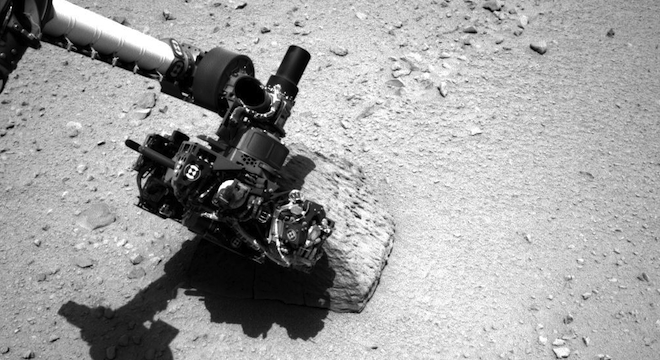NASA’s Mars Curiosity Rover has grasped and analyzed its first piece of the Red Planet — an odd, pyramid shaped rock named after a late NASA engineer, the agency announced on Monday.
The first contact occurred over the weekend, on Saturday, September 22, when NASA engineers maneuvered Curiosity’s 7-foot-long, triple-joined robotic arm into position and used some of the five instruments that are located on the end of it, on the arm’s “hand,” to analyze the rock sample.
The rock sample, which is about the size of a football, according to NASA, was dubbed “Jake Matijevic” by the agency, in honor of one of its own: NASA Jet Propulsion Laboratory scientist Jacob Matijevic, who passed away on August 20 at age 64, after what his obituary described as a lifelong battle with asthma and upper respiratory issues. Matijevic, the man, had served as surface operations systems chief engineer for the Mars Curiosity Rover and was a lead engineer on NASA’s preceding Mars rovers, Spirit and Opportunity.
Here’s a photo of the rock snapped earlier by the Curiosity rover’s left side navigation camera, or Navcam, one of a pair located on its mast:

And here are images posted by NASA showing the rover grappling the rock on Saturday:

NASA on Monday published the following video animation of the rover reaching out its robotic arm to touch the rock named after the celebrated JPL scientist:
NASA specifically used the rover’s Mars Hand Lens Imager (MAHLI) to snap close-up shots of the surface of the rock at three different distances, seen super-imposed on one another in descending order of size in the following image published by NASA on Monday:

NASA said that the MAHLI instrument imagery revealed the rock possesses a smooth surface and is mostly gray in color, with “some glinty facets reflecting sunlight and reddish dust collecting in recesses in the rock.”
But NASA didn’t stop there. The agency also deployed the rover’s Alpha Particle X-Ray Spectrometer (APXS) instrument on the rock, which is designed to press directly against Martian surface samples and bombard them with alpha particles and X-rays, allowing scientists to determine the samples’ chemical composition.
Finally, NASA also fired-up its military grade, rock-vaporizing laser, the ChemCam instrument — a portmanteau of “chemistry” and “camera” — which is actually located on the robot’s mast, the periscope-like protrusion that rises 3.6 feet over the rover’s body, itself 7 feet tall. The ChemCam instrument is designed to be able to allow scientists to fry dust off from rock samples and quickly determine the type of rock in front of it and the proportion of elements that comprise a sample. NASA said in this case, it was used to help cross-calibrate the APXS instrument.
The ChemCam laser finished firing its beams at the rock sample on Monday, the 48th Martian day (or “Sol”) since the rover landed on August 6, 2012 and drove another 138 feet, the longest distance it has covered yet. It’s now over halfway between it’s original landing site in the 96-mile-wide depression known as Gale Crater, and its first scientific target site within the crater, an area of varied and strange-looking Martian geology known as “Glenelg.” But the rover’s ultimate goal is further still: A 3.4-mile-high Martian mountain known as Mount Sharp (also named after a late scientist, Caltech planetary geologist Robert Sharp).






